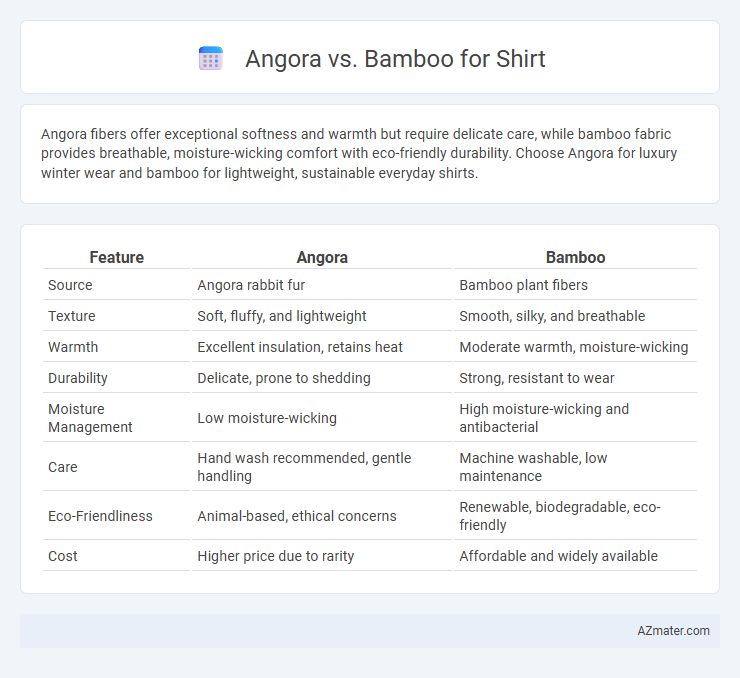Angora fibers offer exceptional softness and warmth but require delicate care, while bamboo fabric provides breathable, moisture-wicking comfort with eco-friendly durability. Choose Angora for luxury winter wear and bamboo for lightweight, sustainable everyday shirts.
Table of Comparison
| Feature | Angora | Bamboo |
|---|---|---|
| Source | Angora rabbit fur | Bamboo plant fibers |
| Texture | Soft, fluffy, and lightweight | Smooth, silky, and breathable |
| Warmth | Excellent insulation, retains heat | Moderate warmth, moisture-wicking |
| Durability | Delicate, prone to shedding | Strong, resistant to wear |
| Moisture Management | Low moisture-wicking | High moisture-wicking and antibacterial |
| Care | Hand wash recommended, gentle handling | Machine washable, low maintenance |
| Eco-Friendliness | Animal-based, ethical concerns | Renewable, biodegradable, eco-friendly |
| Cost | Higher price due to rarity | Affordable and widely available |
Introduction to Angora and Bamboo Fabrics
Angora fabric, derived from the Angora rabbit's fine and soft hair, is renowned for its exceptional warmth, lightweight feel, and luxurious texture, ideal for high-end shirts. Bamboo fabric, made from the pulp of bamboo grass, is celebrated for its breathability, moisture-wicking properties, and natural antibacterial qualities, making it a sustainable choice for comfortable and eco-friendly shirts. Both fabrics offer distinct advantages, with Angora emphasizing softness and thermal insulation, while Bamboo provides durability and environmental benefits.
Origin and Production Process
Angora wool originates from the Angora rabbit, primarily farmed in China and Turkey, with production involving meticulous hand-grooming or shearing to harvest its fine, soft fibers. Bamboo fabric, derived from bamboo grass mainly grown in China and Southeast Asia, undergoes a chemical-intensive process called viscose or rayon production to convert the cellulose into wearable textile fibers. Angora's production emphasizes animal care and fiber quality, while bamboo fabric production focuses on sustainable plant growth but involves more complex industrial processing.
Texture and Softness Comparison
Angora fiber, derived from the Angora rabbit, offers a luxurious texture characterized by exceptional softness and a silky, lightweight feel that enhances shirt comfort. Bamboo fabric, made from bamboo pulp, provides a smooth, breathable texture with natural moisture-wicking properties, resulting in a cool and soft garment ideal for sensitive skin. While Angora excels in warmth and plush softness, bamboo stands out for its durability and eco-friendly moisture management, making both fibers excellent choices depending on the desired shirt feel and performance.
Breathability and Moisture Wicking
Angora wool offers natural breathability and exceptional moisture-wicking properties, making it ideal for maintaining comfort in varying temperatures. Bamboo fabric excels in breathability due to its porous structure, allowing air circulation and rapid absorption of sweat from the skin. Both materials enhance moisture management, but bamboo often boasts superior quick-drying capabilities, providing a cooler feel in hot climates.
Durability and Longevity
Angora fibers, derived from Angora rabbits, offer exceptional softness but tend to be less durable and prone to pilling, which can reduce the longevity of shirts made from this material. Bamboo fabric, derived from bamboo pulp, boasts greater durability and moisture-wicking properties, enabling bamboo shirts to maintain shape and quality over extended use and numerous washes. For long-lasting shirts, bamboo provides superior resilience and wear resistance compared to Angora.
Hypoallergenic Properties
Angora wool, sourced from Angora rabbits, offers excellent hypoallergenic properties due to its fine fibers that resist dust mites and allergens, making it suitable for sensitive skin. Bamboo fabric is naturally antibacterial and moisture-wicking, which also reduces allergen buildup and irritations often caused by synthetic materials. Both fibers provide hypoallergenic benefits, but bamboo's breathability and moisture control may offer superior comfort for those with allergies.
Environmental Impact and Sustainability
Angora fibers, derived from Angora rabbits, pose significant sustainability challenges due to animal welfare concerns and intensive farming practices that impact ecosystems. Bamboo fabric offers a more eco-friendly alternative, as bamboo plants require minimal water, pesticides, and regenerate quickly, promoting soil health and reducing carbon footprint. However, the chemical processes used to convert bamboo into soft textiles can affect environmental benefits unless managed with closed-loop, eco-conscious technologies.
Maintenance and Care Requirements
Angora shirts require delicate handling, including hand washing with cool water and mild detergent to prevent fiber damage and shedding, while bamboo shirts are generally machine washable and more durable, offering easier care with moisture-wicking and antimicrobial properties. Angora's fine fibers demand air drying flat to maintain shape and softness, whereas bamboo fabric typically dries quickly and resists wrinkles, reducing ironing needs. Proper maintenance of Angora significantly extends garment longevity, but bamboo's low-maintenance nature suits busy lifestyles seeking breathable comfort and sustainability.
Cost and Value for Money
Angora shirts typically come with a higher price tag due to the expensive and labor-intensive process of harvesting Angora fiber, which offers exceptional softness and warmth. Bamboo shirts, on the other hand, provide excellent value for money by combining affordability with natural moisture-wicking and antibacterial properties. Choosing between the two depends on whether you prioritize luxury and insulation or cost-effective, sustainable comfort.
Best Uses and Recommendations
Angora fiber, known for its exceptional softness and insulating properties, is best suited for luxury winter shirts and layering pieces that require warmth and a plush texture. Bamboo fabric offers excellent moisture-wicking, breathability, and antimicrobial benefits, making it ideal for casual wear and active shirts designed for hot or humid environments. For durability and eco-friendliness, bamboo shirts cater to sustainable fashion enthusiasts, while Angora is recommended for premium garments emphasizing comfort and elegance in colder climates.

Infographic: Angora vs Bamboo for Shirt
 azmater.com
azmater.com